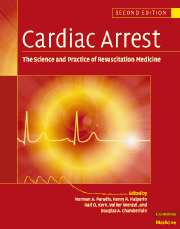Book contents
- Frontmatter
- Contents
- List of contributors
- Foreword
- Preface
- Part I Introduction
- Part II Basic science
- Part III The pathophysiology of global ischemia and reperfusion
- Part IV Therapy of sudden death
- Part V Postresuscitation disease and its care
- Part VI Special resuscitation circumstances
- 52 Prevention of sudden death in patients at risk: channelopathies and arrhythmic syndromes in the structurally normal heart
- 53 Pediatric cardiopulmonary resuscitation
- 54 Resuscitation in elder persons
- 55 Asphyxial cardiac arrest
- 56 Hemorrhagic shock and hypovolemic cardiac arrest
- 57 Cardiopulmonary resuscitation in hypothermic patients
- 58 Cardiac arrest due to poisoning
- 59 Cardiac arrest during anesthesia
- 60 Resuscitation of the pregnant patient suffering sudden cardiac death
- 61 Drowning
- 62 Anaphylactic shock
- 63 High altitude resuscitation
- 64 Electrical injuries
- 65 Rare syndromes, commotio cordis, sudden death in athletes
- Part VII Special issues in resuscitation
- Index
57 - Cardiopulmonary resuscitation in hypothermic patients
from Part VI - Special resuscitation circumstances
Published online by Cambridge University Press: 06 January 2010
- Frontmatter
- Contents
- List of contributors
- Foreword
- Preface
- Part I Introduction
- Part II Basic science
- Part III The pathophysiology of global ischemia and reperfusion
- Part IV Therapy of sudden death
- Part V Postresuscitation disease and its care
- Part VI Special resuscitation circumstances
- 52 Prevention of sudden death in patients at risk: channelopathies and arrhythmic syndromes in the structurally normal heart
- 53 Pediatric cardiopulmonary resuscitation
- 54 Resuscitation in elder persons
- 55 Asphyxial cardiac arrest
- 56 Hemorrhagic shock and hypovolemic cardiac arrest
- 57 Cardiopulmonary resuscitation in hypothermic patients
- 58 Cardiac arrest due to poisoning
- 59 Cardiac arrest during anesthesia
- 60 Resuscitation of the pregnant patient suffering sudden cardiac death
- 61 Drowning
- 62 Anaphylactic shock
- 63 High altitude resuscitation
- 64 Electrical injuries
- 65 Rare syndromes, commotio cordis, sudden death in athletes
- Part VII Special issues in resuscitation
- Index
Summary
Introduction
The pathophysiological changes associated with hypothermia make cardiopulmonary resuscitation a unique challenge in patients with severe accidental hypothermia. Hypothermia offers protection from ischemic tissue injury. Therefore, hypothermic patients have survived prolonged periods of untreated cardiac arrest and resuscitation efforts lasting for hours. The arrested hypothermic heart often does not respond to electrical or pharmacological therapy unless rewarmed. Therefore, diagnosis of irreversible cardiorespiratory arrest is difficult during hypothermia and is often defined as “the failure to revive with rewarming”. It is widely accepted that “nobody is dead unless warm and dead.” In addition to basic and advanced cardiac life support adopted to the particular needs of hypothermia, rapid core rewarming is an essential cornerstone of any resuscitation effort. Extracorporeal circulation is considered the method of choice to accomplish core rewarming in arrested hypothermic patients while offering optimal circulatory support.
Pathophysiology of hypothermic cardiac arrest
Hypothermic cardiac arrest may occur in clinically distinct groups of patients. Cardiac arrest may affect otherwise healthy individuals trapped in cold environments, with cardiac arrest being the sole consequence of the deleterious effects of hypothermia on the cardiovascular system. Cardiac arrest may occur in individuals submerged in ice water or snow, who suffer from asphyxia while rapidly cooling. In these patients cardiorespiratory arrest is, at least partly, a consequence of asphyxia, and hypothermia may offer protection from irreversible ischemic injury when substantial hypothermia has developed before cardiac arrest.
- Type
- Chapter
- Information
- Cardiac ArrestThe Science and Practice of Resuscitation Medicine, pp. 1014 - 1027Publisher: Cambridge University PressPrint publication year: 2007
- 3
- Cited by



